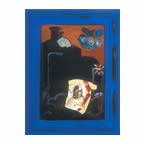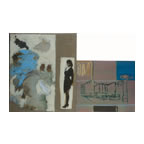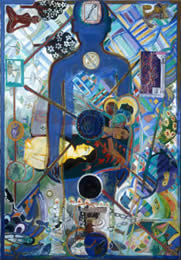JD. Paul, I came to your studio the other day and looked at the last two years or so of your paintings which have changed a great deal. To begin with there are the paintings that I call your layout paintings some of which must have been worked on over twenty years or so. Does it feel like destroying something when you get a painting out and re-work it?
 PGC. You can’t do it unless you are willing to destroy the painting. If you feel that thepainting has got to be preserved it doesn’t work. It’s a case of looking at something and saying well, I’m going to trash this anyway so I might as well repaint it, and in so doing, sometimes there are things that come alive that you want to preserve and go on with.
PGC. You can’t do it unless you are willing to destroy the painting. If you feel that thepainting has got to be preserved it doesn’t work. It’s a case of looking at something and saying well, I’m going to trash this anyway so I might as well repaint it, and in so doing, sometimes there are things that come alive that you want to preserve and go on with.
JD. I imagine it’s like a writer finding a story written ten or fifteen years ago and taking it to pieces and reinventing it. Most artists live with their past sins, put them away and forget about them, but you’ve had the courage go for broke, because some of them you must completely lose.
PGC. I don’t re-work everything. Many things I leave alone, but it’s this thing of suddenly seeing a new possibility or seeing a change that might extend a certain effect so you try it. In the past I probably wouldn’t have been able to do it, but there are themes that I keep coming back to, themes of the street, themes of mythological stuff and I’m always bringing them together in a slightly different way. I think that perhaps a few years ago my street images and my mythological images were juxtaposed and fighting against each other to some extent. Perhaps now they’re more continuous. There isn’t quite such a disjunction and working over paintings allows these shifts to take place.
JD. Yes. The paintings are made up of separate sections: mythological things, memories of India and childhood, the tough kind of London Streets and in another section one person dreaming in a sort of dream bubble.
PGC. Exactly. There are compartments like bubbles where there’s another world going on. Living in London is very exciting but it’s a brutal place as well as an attractive place to be and I think a lot of people feel that. It’s something that’s in the air, and possibly destructive, and a lot of people want to escape from it, so it’s the double reality that I’m trying to get into the paintings. Trying to make a place to escape to.
JD In some of the new paintings you’ve actually done what I thinkyou call joiners, where you literally make one new work by combining two or three separate pictures.
pictures.
PGC Yes, a conglomerate that might even incorporate a work I made twenty years or so ago, but I usually change things because I want them to interact, and I also want the different images to look separate through the play of forms, and colours and so on. It surprises me that five or ten years after a work has been painted, suddenly I can see something that was wrong or something I can do that opens up new possibilities.
JD For me it reflects the way artists are always working. There are artists who achieve continuity like Morandi, which is enviable, but for other more restless people it’s just not possible. I read Matisse’s biography recently and that highlights this cycle of creation, destruction and re-creation.
PGC It’s interesting that even with someone like Matisse, who was so incredibly self possessed and such an amazing artist, that even he was in tremendous doubt right till the end; not knowing whether he was doing anything that was really alive or any good. I think that if you have doubts you will eventually try and find another way of saying something, but if you’re happy with what you do then you stick with the same thing. After a while I just feel that I’m not feeling anything and I know something needs to change.
JD Along with the new layer paintings and these conglomerates your work still incorporates a combination of imagery, but rather than being juxtaposed as separate pictures there is more of a synthesis. You’ve got your London street scenes, your imaginings, dreams and other layers but now everything gets amalgamated. Is this something that you want to push?
PGC It’s possible but something of the intensity that I’m trying to get is to do with generating opposites that demand a kind of conflict. It’s one of the reasons why it’s very difficult to paint a lovely bowl of flowers with the same sort of intensity that one would a subject that was more un-lyrical. In the art of the last hundred or so years, the best paintings have tended to be not of the lyrical kind. I would think in sculpture it’s the same and as a sculptor you also find that, on the one hand you’d like to make lovely things, but that you’re drawn to images of death and so on. You don’t particularly want it but it happens.
JD We certainly live in very disturbing times. Even if we try not to think about it, we are conscious of the war and all the ugly things and brutal things that are going on and I sense it in your paintings. They reflect that strange mixture of physical being and imaginary places which is very difficult to put together pictorially. But what is also interesting is that with your Slade background of observation, measurement and so on, what do you do, you go off into the land of imaginings.
 PGC Some things are paintable within certain ways of painting and some thing are not. Myimagery and my different subject matter and so on always come about from something to do with painting. The subject matter grows from a painting problem which I’m trying to resolve. My liking for mythological imagery and my liking of street scenes are the result of my painterly problems; every time I paint I have an idea that I’m trying to resolve in some way and that’s why in a sense there is never going to be one finite or absolute approach, because the minute you have a solution, or the minute you do something, even if you do it well, it usually breeds something else and so that leads you on to the next idea. Nowadays there are also so many other images to contend with, video and film and so on, that you really have got to decide what painting is. What is essential, what should painting do, what can painting do that no other medium can do. That’s the sort of question that I’m always thinking about. Even if I’m not always resolving it, it’s always there at the back of my mind.
PGC Some things are paintable within certain ways of painting and some thing are not. Myimagery and my different subject matter and so on always come about from something to do with painting. The subject matter grows from a painting problem which I’m trying to resolve. My liking for mythological imagery and my liking of street scenes are the result of my painterly problems; every time I paint I have an idea that I’m trying to resolve in some way and that’s why in a sense there is never going to be one finite or absolute approach, because the minute you have a solution, or the minute you do something, even if you do it well, it usually breeds something else and so that leads you on to the next idea. Nowadays there are also so many other images to contend with, video and film and so on, that you really have got to decide what painting is. What is essential, what should painting do, what can painting do that no other medium can do. That’s the sort of question that I’m always thinking about. Even if I’m not always resolving it, it’s always there at the back of my mind.
JD I’m trying to ask you whether all those images will come together into a …
PGC A style!
JD No, not a style, because I see your painting changing and developing.
PGC Nothing lasts, but once the feeling goes I have to change anyway. I think you asked me once before whether when I run out of paintings to paint over I can do something like make a new image and paint over that, but I can’t, it has to come as a surprise. I can’t will it. I know if I made a painting with the intention of layering, and with the intention of changing, I know it just wouldn’t work. Part of the interest for me of destroying or re-working or re-making things is that it’s a surprise. I have to be able to come by an image and then rip it up so that I can be free with it, and take risks with it, so that I can surprise myself.
JD And does it have to be your own work?
PGC No, it’s possible that one day I may be able to take somebody else’s. My ideal would be to take something like a set of instructions for an electric oven and make a painting out of that; something really basic and banal.
JD With the bringing together of Indian and Western imagery you have created a sort of hybrid that continues to run through all of the new pictures, often in a different way now, but it’s still very much there.
 PGC You are absolutely right but it’s my particular problem, that’s the way I am, that’s theway I’m made. But I would also say that when you look back at other artists, like Picasso taking African art and combining it with western art, you might call that a hybrid but of course we know that when Picasso was taking African masks and putting them into his painting he was extending western painting, and I’m engaged in western painting. I love Indian painting but I’m not trying to paint like an Indian miniaturist. I’m trying to paint like somebody in the 21st century, painting in the west, who has a slightly different background and what I’m trying to do is to open up possibilities for myself.
PGC You are absolutely right but it’s my particular problem, that’s the way I am, that’s theway I’m made. But I would also say that when you look back at other artists, like Picasso taking African art and combining it with western art, you might call that a hybrid but of course we know that when Picasso was taking African masks and putting them into his painting he was extending western painting, and I’m engaged in western painting. I love Indian painting but I’m not trying to paint like an Indian miniaturist. I’m trying to paint like somebody in the 21st century, painting in the west, who has a slightly different background and what I’m trying to do is to open up possibilities for myself.
JD. Do you find anything in common with writers like Hanif Kureishi?
PGC. I don’t like self-conscious multiculturalism. Art should be universal. I think if you are a Russian and you write like Solzhenetsin that’s one thing, but if you are a Russian and you write like Tolstoy that’s another thing, and of course Tolstoy to me is universal. I don’t want to be an English artist or an Indian artist or an English-Indian artist. What I would like to be is somebody doing something now where painting can stand on its own feet against photography, film, and video and installation art and be as exciting and as adventurous, and all the rest of it.
Edited by Michael Richardson from a conversation recorded
at Art Space Gallery, 13 July 2006
John Davies is a sculptor living and working in London